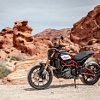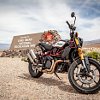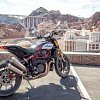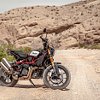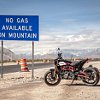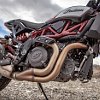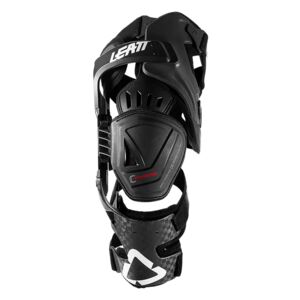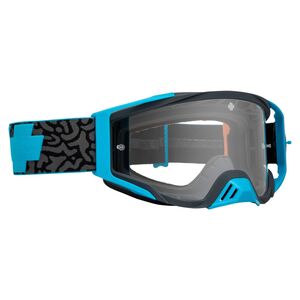So the rear tire on our FTR press bike is toast.
Part of the reason for its early demise was the burnout seen in the photo above, but truthfully, the tire was already starting to show its age. Over the course of testing the Indian FTR 1200 S, Joe Zito (of High Side/Low Side fame) and I logged well over 1,200 miles in a week’s time before having it shipped back to Philly to swap rubber and keep riding.
But I’m getting ahead of myself.
You see, I was never supposed to be the one test-riding the FTR 1200. That was Lemmy’s job. We had agreed that I would cover the unveiling in Germany back in October and then Lem would get to be the first to ride it. We try to ham and egg things as fairly as possible (while occasionally letting Greaser and Lance have some fun).
But our plans changed when Lem’s surgery (to repair an injury from, ironically enough, racing flat track) meant the big guy would be unable to ride a motorcycle for weeks. That threw a pretty big wrench into our plans for a multi-tiered review of Indian’s all new FTR 1200 S.

The scale of the video production involved multiple locations, the involvement of six-time AMA National Flat Track Champion Jared Mees, and testing a completely new motorcycle that a lot of you were anticipating. Plus, Indian had agreed to let us give away the bike via our Open It Up Sweepstakes.
The show, as they say, must go on. And this is why you’re reading my account of Indian’s new FTR 1200 S and not Lem’s.
From city streets, to four-lane freeways across the Nevada desert, to narrow mountain passes and sandy dirt roads, we piled the miles on this bike. My primary goal was to determine whether the FTR 1200 S actually lives up to the expectations and hopes it raised. If you’re interested in an in-depth review of Indian’s newest motorcycle, you’ve come to the right spot.

The Indian FTR 1200 S
Lemmy could break down the historical significance of the Indian FTR 1200 better than anyone I know. Given the opportunity, he’ll rant ad nauseam about the performance battles between Indian and Harley from the early 20th century and the fact that Indian and Harley-Davidson used to build performance machines, not just the cushy cruisers they’ve become known for.
And in case you haven’t been following the American Flat Track series lately, suffice to say Indian has kicked ass with its FTR750 race bike. Mees won the title the last two years on an Indian and FTR750s won 17 of 18 races in 2018.

The FTR 1200 draws on the classic style of a flat-track race bike and builds on the company’s success on the dirt ovals of America, but it does it with a sporty, standard motorcycle that is intended to take Indian in a new direction. Indian has been promising it will move beyond cruisers and touring bikes, and the FTR 1200 is the first step. Thus it’s important to the future success of the brand.
The Indian FTR is built around a torquey, 60-degree, DOHC, 1203 cc V-twin engine that features a claimed 120 horsepower at 8,250 rpm and 85 foot-pounds of torque at 6,000 rpm. Redline doesn’t hit until 9,000 rpm and power comes on later in the rev range.

Power is delivered via a six-speed gearbox and a slipper/assist clutch. The FTR features a chain final drive, which is a departure from the belt-drive cruisers in Indian’s lineup. But the FTR isn’t a cruiser and a chain is the most efficient way to deliver power from the engine to the rear wheel.
All-new Dunlop DT3-R tires were designed specifically for the Indian FTR, a 150/80R18 rear and a 120/70R19 front. Unlike Dunlop’s DT3 race tires, the “R” features tread blocks which are closer together and have a shallower depth. I was very surprised with the amount of grip these tires featured on the street. They were much stickier and provided a smoother ride than I expected, given their tread pattern. Off-road, however, they were more slip than grip.

The front wheel features dual Brembo M4.32 monoblock four-piston calipers, which provide superb stopping power. I liked the adjustability and feel from the front Brembo brake lever and I was disappointed that the clutch lever wasn’t adjustable, as well. A Brembo P34 two-piston caliper covers braking duties at the rear wheel. Shooting the promo video with Jared Mees, it became clear he thoroughly enjoyed the rear brake on this bike, especially after he figured out how to turn off the ABS.
ABS is standard on all FTR models, but can be disabled only on the S models via the 4.3-inch, Ride Command LCD touchscreen display that replaces the analog dash of the base FTR. In addition to switchable ABS and a touchscreen dash, the S model offers switchable traction control, wheelie mitigation control, and stability control via an inertial measurement unit (IMU), which takes lean angle into account. The S also adds rider modes (rain, standard, and sport), which alter throttle feel and the intervention of the traction control system.

The S model receives an upgraded adjustable suspension. Designed by ZF, the German firm currently building BMW’s high-end suspension components, there is adjustability for preload, compression, and rebound damping at the front fork as well as the rear shock. (ZF also owns Sachs, which is why you might notice a Sachs logo stamped into the metal on the rear shock.)
But most of that I covered in my first look article back in October. Let’s ride.

Riding the FTR 1200 S
If you check out Indian’s website, there are four packages you can purchase to customize your FTR 1200 to change its style as well as a bit of its functionality: Sport, Tour, Rally and Tracker (the last two are off-road biased). So I set out to test the stock bike in those same four scenarios.
The bike was waiting for me at our facilities in Las Vegas. Our FTR was literally brand new and the first order of business was to install the battery and mirrors. The battery hangs low in front of the engine, and without a skid plate protecting it, seems extremely vulnerable to off-road abuse.

My first stop with the bike was to top off the fuel tank before heading north on I-15 out of the city. The gauge in the upper left hand corner of the dash let me know that I had a range of roughly 125 miles. What I wasn’t sure of was whether that was my distance to empty or to reserve. I made a note to check on that.
The FTR’s engine is cold-blooded and needs about five minutes to warm up. Once it's nice and toasty, it pulls hard and quick through the gears, and can hold highway speed all day long. The one thing to note here is that unlike some more cruiser-focused V-twin platforms with immediate torque and low redlines, the FTR is a revver. I found it was happiest between 4,500 rpm and 8,500 rpm. While this is nothing for the sport crowd, I think it could prove to be a bit surprising for folks coming to the FTR from a cruiser.
The electronic cruise control works seamlessly and I used this feature more than I anticipated. I wish that I had a clip-on windscreen with me to block some of the wind on the highway, but that’s an easy enough modification. The seating position is surprisingly upright and your feet sit directly underneath you, if not slightly behind. While I’m not a huge fan of endless freeway riding, the FTR was impressively comfortable, considering its stock form.

Turning off the freeway and onto a dusty stretch of two-lane blacktop called The Valley of Fire Highway, I decided to top off the gas tank and grab some snacks before riding into Nevada’s Valley of Fire State Park.
I couldn’t have been parked for more than 15 minutes, yet I talked to no fewer than seven people about the FTR 1200. Before I could get my helmet off, an elderly gentleman approached me to inquire about the Indian. I explained a bit about the model and that I was testing the bike, and then I walked inside. When I came out, there was a small crowd around the bike, young and old, and the man was repeating the information I had told him as if it were his. The overall scene just made me smile.
This became a theme for nearly every stop I made with the bike. The style, fit, and finish of the FTR are impressive. The large Indian script logo on the tank is an eye catcher. While I’ve heard comparisons to other models of motorcycles (i.e., Ducati Monster), for the majority of people I talked to in person, the FTR 1200 looks unique and the brand name has wide recognition.

Riding through the Valley of Fire and then down Route 167 to the Hoover Dam, I took a few opportunities to pull off down dirt roads. While it was immediately clear this bike was not a dual-sport, or even an adventure bike, I was more comfortable with the FTR off-road that I would have been with a sport bike or a cruiser. I made a mental note that the Dunlop tires do not appreciate sandy washes and that I’d have to find something a bit more hard-packed to really give the FTR a proper shakedown in the dirt.

My second day with the FTR started with a warning light on the dash. The cool thing about the FTR’s dash is that it allows you to check engine fault codes with the push of a button. Code U1112 turned out to be an “ABS Lamp Information Failure” notification with a resolution to take it to the dealer. Instead, I came to a couple of aggressive stops to make sure that the ABS was in fact working, and spent the rest of my time ignoring that little light (if the circumstances were different I would have just swung by the dealer and had them clear the code).
I rode across the desert on Route 157 to the snow-capped peaks of Mount Charleston. The FTR’s longer 60-inch wheelbase allowed for stability on the highway but the steering geometry balanced out the experience. It handled the long, fast sweepers with ease. This is where the bike really started to show off. It excelled at hustling me through these corners.

As I climbed in elevation above 8,000 feet, the temperature dropped from the 70s to the low 40s and all of a sudden my perforated Alpinestars Brera jacket didn’t seem like the best choice. Storm clouds loomed heavy on the horizon as I continued on. I was happy when the road looped back off the mountain and I found myself on warmer ground. The desert was in full bloom and almost seemed to rise up and meet the base of the mountains. It made for a hell of a photo stop.
Early the next morning, I headed out in our rental van and picked up Mr. Zito from the airport. Joe was part of the team joining me for the video portion of the review, which we were shooting at Lake Arrowhead, California. The rest of the folks would meet us there, but Joe and I were tasked with picking up supplies and getting the bike across the desert.
With a support truck and spare gas, we figured this would be the perfect time to test the FTR’s fuel range.

Joe took the first shift behind the bars and we headed south on I-15 towards Barstow, California. The FTR ran out of gas at 134.5 miles. Remember that question I had earlier about the range indicator? The number is referring to the FTR’s range to empty. We had traveled with the cruise control locked at 71 mph with the bike in sixth gear, engine sitting just above 4,000 rpm, and we averaged 39.55 mpg.
While I know this range will be a deal-breaker for some, I am not willing to dismiss its touring capabilities on this alone. It reminded me a lot of the trip I took on the Triumph Street Twin when I rode it, 300 miles a day, on two-lane country highways, from Atlanta to Austin, Texas for MotoGP. I like stopping every hundred miles or so to stretch my legs and talk with the locals. The FTR would excel at that type of touring.
Reaching our destination in Lake Arrowhead, we discovered a maze of winding mountain roads. For all of my time living and traveling in California, this was my first time in the mountains east of I-15. On this trip with the FTR, I discovered Route 138, which connects the high desert in the north to a small mountain lake community with a beautifully tangled mess of asphalt.

There were tight first- and second-gear corners, as well as stretches that allowed me to hold on to third gear longer, hanging out near the redline. The FTR isn’t a sport bike, but it’s much sportier than I was expecting.
At first, sand and gravel in the corners had me slowing down to make sure I didn’t slide off the side of the mountain. But soon I learned to trust the electronic aids. Some corners required a more docile entry speed, but exiting the apex I could crack the throttle and accelerate hard. The rear might give a little slide, or the front wheel would lift slightly, but the FTR would quickly settle itself. And it did so in seamless fashion, without any abrupt “cutting” feeling. I rode in Sport mode most of the time I was on the street.
When slowing for entry speeds, one of the things that surprised me was the amount of engine braking I was getting from the FTR. I have ridden some motorcycles with slipper clutch setups that limit engine braking more than I would like, but not on this Indian. I really dug the feel with this setup. And when I needed extra help, those Brembo calipers worked nicely to halt this bike quickly.

The suspension seemed plush on the highway, yet simultaneously planted in the twisty stuff. The front fork and rear shock both feature 5.9 inches of travel, which is more than what you would see with a typical sport bike or cruiser, but less than what an adventure bike would provide. It’s this weird middle ground that works well on the street, providing a balanced, sporty ride without being overly harsh. The dirt, however, was another story.

Aside from a few sandy washes in Nevada, I hadn’t really had a chance to don my dirt gear and give this bike a proper thrashing off-road. Over dinner on the first night, we discussed a few alternatives and decided on Elliot Ranch OHV Road, outside of Alray, California.

Elliot Ranch OHV Road was a hard-packed dirt road with a few sandy corners and deep grooves cut by the rain. There were certain sections where I could pick up speed and have fun sliding the bike. Those sections would be followed by butt-puckering moments where I would round a corner to find a dropoff that would have me scrambling to slow down the FTR before banging my way through a rutted and worn section of the trail.
The controls were hard to navigate off-road. The pegs, with their slight rearset and forward pitch, were hard to stand on. The handlebar, for as upright as it was, was still too low and sporty. The nearly six inches of suspension travel wasn’t enough to soak up the bigger hits. The tires’ tread didn’t provide enough grip to really dig into the terrain (they’re designed to slide across a well groomed track). As I wrapped up my day in the dirt, I couldn’t help but notice the plastic tank panels looked pretty thrashed from my off-road pants and knee braces after just one ride.

I started this review by saying that I was getting ahead of myself by talking about a worn-out rear tire. So here’s where we get back to it. By the end of my day off-road, the tire was starting to get a bit ragged. The DT3-R is softer and stickier on the street than I expected, and I'd wager under regular riding conditions you should expect to see 3-4,000 miles out of a rear. Ours, however, didn’t make it that far. Rather, it died prematurely, sacrificing itself in the name of a smokey burnout.
We had originally planned to have Indian send us a spare tire to Philadelphia so we could freshen the bike up upon our return. However, in the course of the review we noticed a small stumble in the fueling between 3,000 and 4,100 rpm. Our friend Jeff Millard at The Brand Amp, Indian's marketing agency, immediately put us in touch with Ben Lindaman, Indian's International Product Director. Ben was concerned with what he was hearing and asked us to sit tight while he and his team looked into it.
The issue was almost a "searching" when trying to hold a steady speed within this specific rev range. It felt like the FTR couldn't make up its mind as to how much fuel to deliver, a symptom of the bike running lean at lower engine speeds to pass emissions tests. This isn't unlike some of the fueling issues we've seen from other manufacturers. Most recently, the KTM 790 Duke comes to mind. I didn't expect that there was much that could be done.

Because of this, I was extremely surprised when Ben and his team decided to update the fuel map for the FTR, based on our recommendations, that would be programmed into all final production bikes. Then, instead of just sending us a new tire, they shipped us a brand new FTR with the revised fuel map for us to test.
Joe and I have both been riding this second bike around Philadelphia and feel that the issue is vastly improved over the FTR we rode out West. While there is still a little stumble just shy of 4,000 rpm, I doubt we'd have even noticed it if we hadn't been looking for it so closely. I was genuinely impressed with the efforts Indian went to in order to fix this one little issue. They could have just as easily blamed governmental regulations and said their hands were tied.
Pricing and competition
The FTR 1200 is available in three different flavors: the base model, the S model, and the Race Replica model. The base version, available in black only, starts out at $13,499. This is $500 more than what we originally reported from the launch in Germany. The FTR 1200 S, which adds adjustable suspension, traction control, an IMU, rider modes, and switchable electronics via the LCD touchscreen is $15,499 (again, $500 more than initially reported) and is available in two additional colors. Our bike, as tested, was $16,999 in the Race Replica paint scheme with the Akrapovic exhaust and retuned ECU. There is a pretty decent range to the pricing, but I would argue the “S” version would be the way to go.

I’ve heard a lot of people try to compare the FTR to a Ducati, but I think the better comparison would be something from Triumph’s lineup. I foresee a lot of cross shopping between the FTR and bikes like the T-120 or the Scrambler 1200. While the Scrambler is more capable off-road, the FTR is sportier than both of those bikes by a long shot. You could also draw clear comparisons to BMW’s R nineT lineup.
What none of those competitors can match — and what no doubt drew that little crowd at my very first gas stop in Nevada — is the FTR’s flat-track styling. Those other bikes are styled like variations on the themes of café racers or cruisers or scramblers. The Indian is the only production motorcycle that mimics a tracker, right down to the tire treads.
Along those same lines, it’s important to note that the one company that currently has nothing to compare to the FTR 1200 is Indian’s oldest rival, on the street and on the horse tracks of America: Harley-Davidson. Yes, Harley has new bikes in the works, but when the FTR 1200 hits dealer showrooms at the end of May, there will be no American-made competitor to contend with.

Conclusion
The FTR 1200 is not a sport bike, or a touring bike, nor is it a dirt bike. That being said, I would never want to take a sport bike off-road, a touring bike would not be my first pick for canyon carving, and a dirt bike would rattle me to death at highway speeds. The FTR is a standard motorcycle that can do a little bit of all of those things, rolled into one package, with a style different from anything else being produced right now by a major manufacturer.
I liked the FTR best when I was riding it around town and traversing mountain passes. It excels as a sporty, day-to-day motorcycle. Commute on it, escape the city on it, crack the throttle open and have some fun on it. It won’t disappoint.
Where I liked it the least was off-road. This bike is very heavily street-biased. While you can have some fun on a hard-packed dirt road, it’s not really designed for that, even if Indian does sell a Rally or Tracker package. If I were looking for something more functional off-road, I’d check out an adventure bike.

The area that surprised me the most was the touring ability of the FTR 1200. With a little bit of modification, this bike will work really well as a lightweight, two-lane touring machine. While I would avoid long days on the interstate, it really just needs some luggage, a windscreen and a rider who’s willing to stop and top off the tank every 100 miles or so.
There were a few areas that bothered me on the FTR 1200. The mirrors don’t match the overall aesthetic and the clutch lever isn’t adjustable. Both of these items feel cheap compared to the rest of the bike. I looked for replacements and while I found mirrors, it doesn’t look like there is currently a replacement for the clutch lever. Same with the fuel filler cap. The locking fuel cap was a pain in the ass to use and keep track of at the pump. I wish they would have just used a flush-mounted sport-bike-style filler cap.
The engine runs hot in traffic, but unfortunately this is becoming the norm for bikes designed to pass the upcoming Euro 5 regulations. Even here in the United States, California is cracking down on motorcycle emissions. OEMs have to jump through a lot of hoops to get these bikes to pass governmental regulations, and unfortunately, something like excess heat is often the byproduct.

All things considered, the FTR 1200 S is a damn good motorcycle, especially for Indian’s first attempt at manufacturing something outside of their comfort zone. It comes out swinging. Great engine, great chassis, great brakes, and a great suspension (assuming you go with the “S” version). If this is a sign of what’s to come, I can’t wait to see what Indian has up its sleeve for the future.
That being said, our time with this bike is coming to an end. If you want a chance to win a brand new FTR 1200 S Race Replica that has been customized by Lemmy, along with some cool gear from Alpinestars and Bell, make sure you enter our Open It Up sweepstakes.
| 2019 Indian FTR 1200 S | |
|---|---|
| Price (MSRP) |
$13,499 FTR 1200 $15,499 FTR 1200 S $16,999 FTR 1200 S Race Replica |
| Engine type | Liquid-cooled, 60-degree V-twin, DOHC, four valves per cylinder |
| Displacement | 73 ci (1203 cc) |
| Bore x stroke | 4.016 inches x 2.898 inches |
| Compression | 12.5:1 |
| Power (claimed) | 120 horsepower @ 8,250 rpm |
| Torque (claimed) | 85 foot-pounds @ 6,000 rpm |
| Transmission | Six-speed, constant mesh |
| Front suspension |
43 mm inverted ZF cartridge fork (FTR 1200) Fully adjustable 43 mm ZF inverted cartridge fork (FTR 1200 S) |
| Rear suspension |
Monotube ZF shock with preload adjuster coil (FTR 1200) Fully adjustable ZF Piggyback shock (FTR 1200 S) |
| Suspension travel front/rear | 5.9 inches / 5.9 inches |
| Front brake | Twin 320 mm discs, radial-mounted Brembo M4.32 monoblock calipers |
| Rear brake | Single 265 mm disc, Brembo P34 two-piston caliper |
| Tires front/rear | Dunlop DT3-R 120/70R19, Dunlop DT3-R 150/80R18 |
| Rake | 26.3 degrees |
| Trail | 5.1 inches |
| Wheelbase | 60 inches |
| Seat height | 33.1 inches |
| Tank capacity | 3.4 gallons |
| Dry weight (claimed) |
488 pounds (FTR 1200) 489 pounds (FTR 1200 S) |





